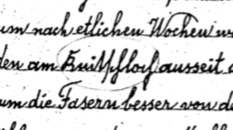George "Großvater" Aberth's Memoir
In 1931, at the age of 74, and having lived in America for 19 years, George "Großvater" Aberth wrote a sort of memoir titled »Erinnerungen und Erlebnisse!« ("Memories and Life Experiences!").
The document consists of about 60 pages of hand-written High German.
I must extend a special thanks here to Cousin Rosemary – the current owner of the original German document. At some point in the last couple of decades, she commissioned an English translation of the memoir. You can find a link to that (excellent) English translation as either a downloadable PDF or as searchable HTML text below.
| English | German |
|---|---|
| English Translation as HTML/Searchable Text | Original German as HTML/Searchable Text |
| English Translation [PDF Download – 38 MB] | Original German [PDF Download – 38 MB] |
In 2019, Rosemary was kind enough to send me a high-quality facsimile of the original German document. I wanted to see the original, as I was curious about a few details such as:
- What dialect of German did Großvater speak? German is notoriously divided among countless regional dialects, including one called "Alsatian" from Alsace. Did Großvater speak this or any other regional dialect?
- Which cursive script did he use? Germans had their own special cursive handwriting script called Kurrent which was widely used before the 20th Century. Did he use that?
- What figures of speech did Großvater use?
When I first laid eyes on the facsimile of the German original, I was surprised. I found the memoir to be an unexpectedly modern document.
The handwriting is very clean and extremely easy to read. It's written in the same standard modern cursive script we use today, not the German Kurrent cursive script of the 19th Century.
The text does not reveal any obvious hints of any regional dialect. Rather it's written in thoroughly modern, standard High German – the "lingua franca" of today's German-speaking realm including Germany, Austria, Switzerland, etc.
This is surprising because geographically, I expected that Alsatians of the 19th Century would have spoken a Low German dialect, either Alsatian (Elsässisch) or maybe South Franconian (Südfränkisch) or perhaps most likely, a Vorderpfälzische Dialect called Elsässisch-Pfälzisch. In fact, cousin Rosemary (grand-daughter of Großvater) says her father, Martin Aberth, spoke Low German. She says that she took German in high school, and that when she would ask her dad for help with her German homework, he would remark about how strange her High German school textbooks were.
One explanation for this is that Großvater must have been well-educated as a child. Even though he spoke a Low German dialect, he must have been educated to only write in standard High German. This is definitely the way education works in modern Germany today, but I was a little surprised to find that this would be the case in the 19th Century. So although this is a little surprising, I guess I find it plausible – and the most likely explanation.
Above, I said the memoir was written in our standard modern cursive handwriting script. That's true except for one single word in the document, »Knitschloch«, which was written in the archaic German Kurrent script.
»Knitschloch« is a bit of an odd word, and it's certainly a very rare one as well. »Knitsch« means to grind or to pulverize and »Loch« means hole. George was describing a local milling block or grinder where hemp seeds were ground or pulverized.
Why did he write this single word in the Kurrent script? I have no idea. The original translator must have thought this was strange as well, because the word is lightly circled in the German original document – at least I assume that circle comes from the translator.
There are, of course, many fascinating aspects to Großvater's memoir, but one I found particularly interesting is his first-hand account of the Battle of Wissembourg (1870). His account begins on page 8 of the English translation PDF.
It seems this battle – which took place in the direct vicinity of Steinseltz – is a somewhat famous battle. It was the first real battle of the Franco-Prussia War (1870-1871), which ultimately lead to the long-awaited German Unification. It also lead to the return of German control in Alsace.

